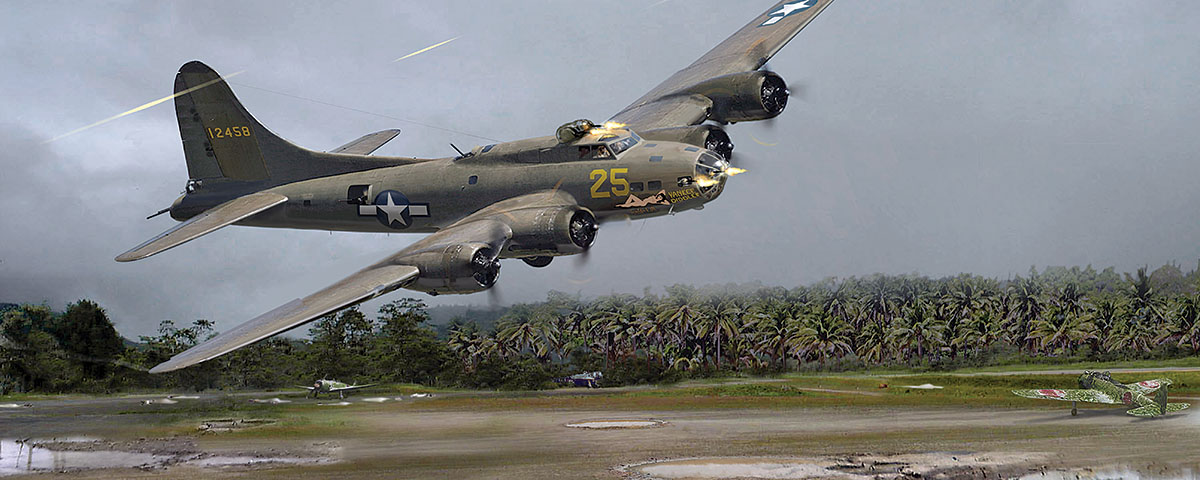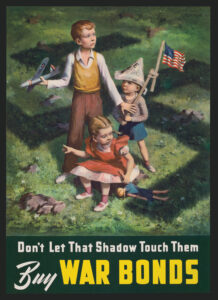In 1943, when hundreds of B-17s routinely sortied over Europe, a B-17 mission in the Southwest Pacific theater never amounted to more than 30 Flying Fortresses. Fifth Air Force commander Lt. Gen. George C. Kenney argued for more B-17s following the Battle of the Bismarck Sea in March 1943, but military planners told him the Boeing bombers were going to Europe and he would be getting Consolidated B-24 Liberators to replace his aging Fortresses. So between May and October 1943, Kenney’s only B-17 bomb group, the 43rd, became a B-24 outfit. Some of its well-worn B-17s were sent home to serve as trainers and several became runabouts for generals, but 12 were selected for a special mission as armed transports.
Supplying coastwatchers and other Allied intelligence units operating deep in enemy territory was a vital but dangerous task, and potentially a deathtrap for the unarmed Douglas C-47 transports. The B-17s, capable of carrying a heavier load for a greater distance and armed with 10 or 11 machine guns, were a perfect fit.
In November 1943, six B-17Es and six B-17Fs—serial nos. 41-2408, 41-2432 The Last Straw, 41-2458 Yankee Diddler, 41-2657, 41-2662 Spawn of Hell, 41-2665 Lulu, 41-24353 Cap’n & The Kids, 41-24357 Blonde Bomber, 41-24358 Lulu Belle, 41-24381 Panama Hattie, 41-24420 Caroline and 41-24548—were thoroughly overhauled, modified and repainted by the 4th Air Depot Group at Townsville, Australia. “One of the first things they did was remove the ball turret because of the possibility of entanglement of the parachutes during a drop mission,” recalled Jack Hoover, a pilot in the 317th Troop Carrier Group. “All the other guns were left operational.
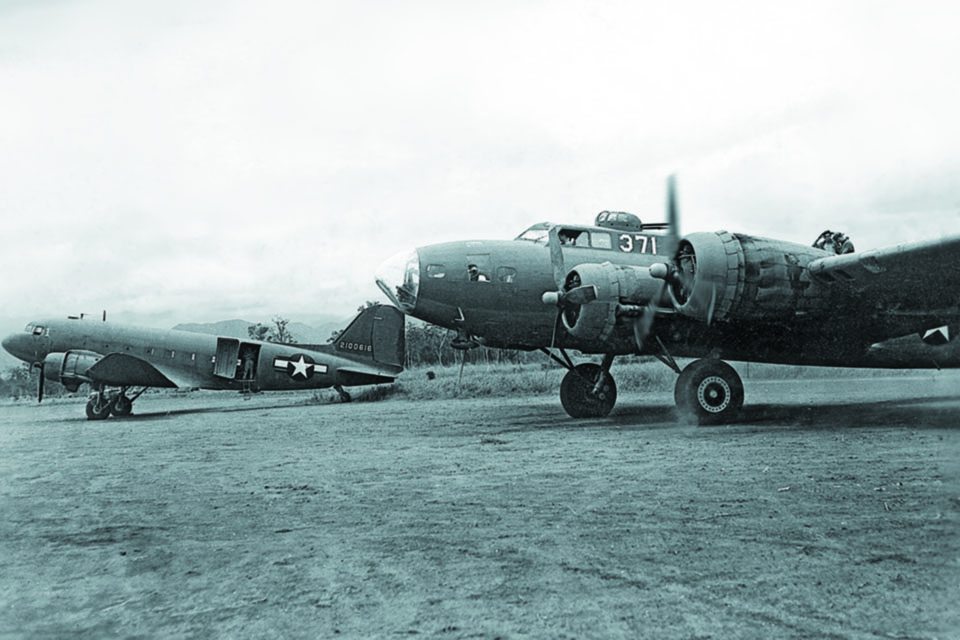
“The bomb bay was the more important part of the reconfiguration. The racks and shackles were removed. Bins were constructed on either side and a steel cable affixed to the area above the bins to attach the parachute static lines. The bottom of the bins were on hinges with electric switches for release, and the release switches were located right in front of the pilot.”
The 12 modified B-17s were assigned to the 54th Troop Carrier Wing, based at Port Moresby, New Guinea, with one airplane going to each of the four squadrons of the 317th and 375th Troop Carrier groups and two assigned to the 433rd Troop Carrier Group. The remaining two B-17Fs apparently served as a personal transports.
A lot of history lingered in those veteran bombers—41-2408 was the oldest B-17 in the Fifth Air Force and, with 41-2432, had flown into the maelstrom over Hawaii on December 7, 1941. Yankee Diddler was a survivor of the Java campaign, and Lulu had flown in the Battle of Midway. A couple of the B-17s retained their earlier nicknames, while others acquired new ones—Lulu became Pretty Baby, Blonde Bomber was soon The Super Chief, Caroline was “G.I.” Jr. and 41-24548 was dubbed Harry the Horse.
The first crews were composed of men from the 43rd Bomb Group who had come in as replacements or didn’t have enough points to go home with the rest of their crew, as well as men from the troop carrier squadrons. Extra gunners were borrowed from the bomb groups as needed.
Yankee Diddler joined the 39th Troop Carrier Squadron on November 27 and immediately went to work. Pilot Ted Bauries remembered, “We were feeding the coastwatchers up there around Rabaul by taking off in the dark in the morning, getting there at daylight and dropping food and so forth to them, then come back and fly C-47s…the rest of the time.” Jack Hoover added, “Sometimes we would free fall rations and other types of cargo…this was sort of iffy as we would drop the gear and fly as slow as possible, close to the ground.”
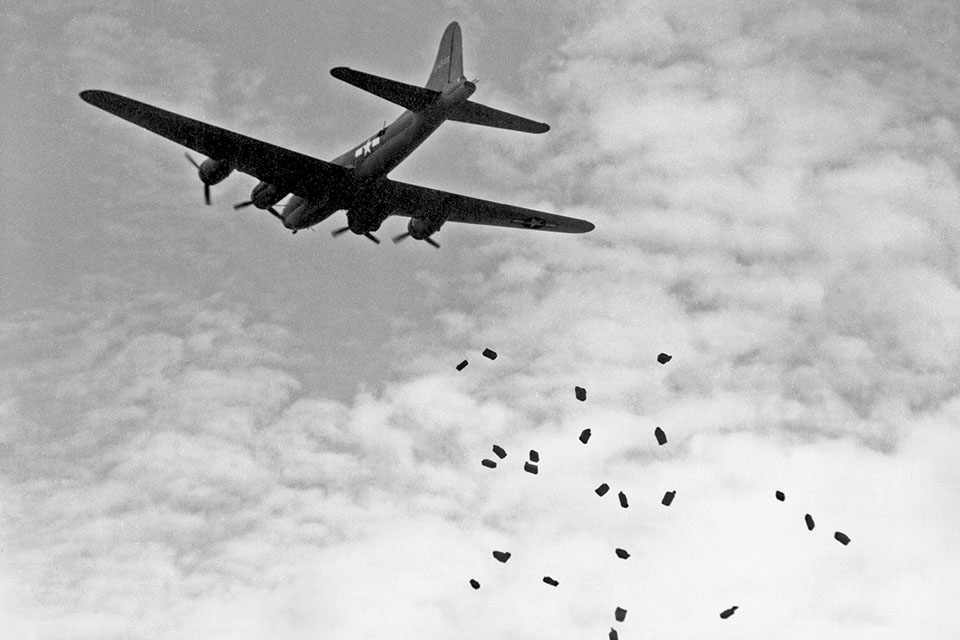
As early as August 1943, Allied leaders had decided to bypass the Japanese stronghold at Rabaul, on New Guinea’s New Britain island. The Allies still wanted a foothold on western New Britain in order to control the sea lanes between it and the New Guinea mainland, so amphibious landings were scheduled for Cape Gloucester on December 26, following a diversionary raid at Arawe, about 60 miles southeast, 11 days earlier.
The Arawe landing force encountered heavy opposition and requested complete resupply. Four tons of food, ammunition, raincoats and medical supplies were loaded into Captain Lee Bird’s Yankee Diddler, which was standing by at Dobodura, the Allies’ advanced base on the east coast of New Guinea. Yankee Diddler headed out across the Solomon Sea for New Britain, flying just 150 feet above the ocean.
“Our only worry was that our own boys might think us Japs and open up,” said navigator Lieutenant Seymour Schafer. But all they saw were friendly troops waving from a road running down the middle of their target, the Amalut coconut plantation. Yankee Diddler circled and completed the first drop, then circled again while crewmen reloaded the bins. Tail gunner Staff Sgt. Paul Blasewitz, a 43rd Group veteran who amused himself by singing tenor solos over the interphone, simply said, “The mission was a cinch.”
The “new” B-17s also came in handy for a broad range of special assignments. On February 21, 1944, The Super Chief dropped 50 bags of food on a dry creek bed near Open Bay on New Britain, then photographed a volcanic lake to assess the feasibility of landing a PBY Catalina on it to rescue downed Allied airmen. And 41-2408 made at least one unofficial beer run to Australia from New Guinea.
During the invasion of the Admiralty Islands, eight B-17 armed transports stood by at Finschhafen, about 300 miles away on the New Guinea mainland, in case they were needed. They would be.
The invasion began as a reconnaissance-in-force on February 29, when a little over 1,000 cavalrymen landed on Los Negros Island, about 200 yards from the Momote airstrip. The men seized the airstrip by 0950 hours, but when returning patrols warned of a large Japanese force nearby, the Americans abandoned the strip’s southern reaches in order to tighten their perimeter.
Yankee Diddler took off from Finschhafen soon after daybreak on March 1, and was over Los Negros at 0830 with a full load of mortar shells, small arms, ammunition and blood plasma. An onsite Army controller told the pilots, Captain Bird and Lieutenant Ted Bauries, to strafe the western side of the airfield to suppress Japanese snipers before dropping the supplies. They made four strafing runs at treetop level, expending 2,000 rounds of .50-caliber ammunition and completing three dropping passes.
Yankee Diddler was back over Momote by midafternoon with a load of barbed wire, hand grenades, anti-personnel mines and more ammunition. After three drop runs, the Army controller requested that they assist a destroyer that was shelling a village to the northwest, and they made three strafing passes there before heading home.
Over the course of the day, Harry the Horse, “G.I.” Jr. and the two B-17Es from the 375th Troop Carrier Group dropped a total of 12 tons of blood plasma, weapons, ammunition and barbed wire. Captains Paul Wentz and James Sweet in “G.I.” Jr. went to the aid of a group of barges that were under fire from Japanese positions west of the airstrip, silencing the enemy guns until the barges were safely ashore. The 433rd Troop Carrier Group’s Cap’n & The Kids and 41-2432 made three drops over the Americans, then three strafing passes over the Japanese lines.
The next morning Yankee Diddler was over the airstrip at 0830 with a load of supplies, and again received orders to strafe the enemy positions. The gunners expended another 2,000 rounds in three passes, setting gasoline drums afire and suppressing the snipers.
Cap’n & The Kids was back midmorning with a cargo of ammunition and a crew of 14, including five enlisted men from the 90th Bomb Group to man guns and assist with the drops. Pilot Flight Officer Ralph Deardorff was flying at 400 feet and in radio contact with a Navy destroyer directing air operations over Los Negros when he heard urgent calls over the intercom and a clatter of gunfire from the rear of the plane. He couldn’t see it, but a Ki-61 Tony was flying parallel with them, slightly higher and coming fast. Right waist gunner Staff Sgt. Paul Martin got off a few bursts, but then his gun jammed.
The Japanese fighter overtook the B-17, rolled in to make a firing pass and dived away. A second fighter attacked from two o’clock, passing under Cap’n & The Kids without inflicting any damage. Meanwhile, Deardorff raced for the destroyers and the umbrella of gunfire they could provide.
When another Tony attacked from about three o’clock high, radioman Staff Sgt. William Mathis and top turret gunner Private Brian Marcorelle both fired at it before it turned to begin another attack from nine o’clock. Left waist gunner Tech. Sgt. Alfred Crossen reported that as the Tony “headed back toward us…I put several bursts into him in the engine and right wing, and as he came on I put more bursts in him…[and] he suddenly turned right….[H]e was smoking as he turned.” The Japanese fighter broke away about 200 yards out, and tail gunner Staff Sgt. Walter Graves squeezed off a burst as it flashed past. Deardorff said the fighter “exploded when it hit the water and a large flame and high column of smoke shot into the air, a hundred feet or so.”
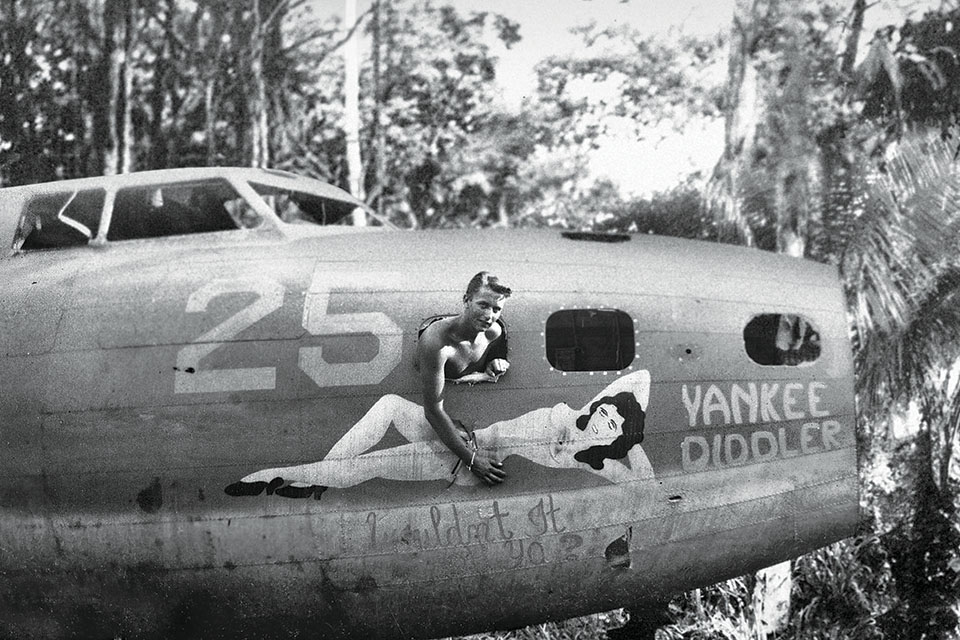
Although success in the Admiralties was assured by the morning of March 4, the B-17 missions to drop supplies and strafe enemy positions continued for a couple of weeks. On March 14, Lieutenants James Bennett and Chester Brown in 41-2657 were fired on during a drop mission and collected a few holes in the right wing, but nobody was hurt. By then the missions had become milk runs.
Four B-17s took part in an extended mission on April 22 with the 317th Troop Carrier Group, which had been tasked with providing armed transports for special operations in support of the landings at Hollandia, 500 miles up the New Guinea coast. In May Cap’n & The Kids dropped 7,000 pairs of combat boots to infantrymen battling entrenched Japanese on the island of Biak, and when the 503rd Parachute Infantry jumped onto Noemfoor Island on July 3, three B-17s followed in single file close behind, dropping supplies and ammunition.
The armed transports had taken hits but suffered no losses in nearly six months of operations. That changed on May 4, when Harry the Horse was returning from a routine Hollandia mission. Running low on fuel, Lieutenant Robert Kennedy decided to make an emergency landing at the recently repaired Tadji fighter strip. As the wheels touched the runway, the right landing gear collapsed and the bomber swerved to the right, dragging the wing along the ground. Nobody was injured, but the B-17 was damaged beyond repair.
As the focus shifted toward the Philippines, the armed transports’ numbers thinned. On May 16, the 433rd Troop Carrier Group sent 41-2432 to Townsville Air Depot for repair and it never returned. The 317th shows no record of B-17s on strength after June 1944. The 375th’s 41-2662 was involved in a taxi accident in July and not returned to the group after repair. Cap’n & The Kids was transferred out of the 433rd on August 10, but its career was far from over. Renamed Miss Em’, it completed a further 160 flights as Eighth Army commander Lt. Gen. Robert L. Eichelberger’s personal transport. Squadron records indicate that both “G.I.” Jr. and 41-2657 flew through February 1945, then were transferred out the following month.
All but one of the surviving armed transports were ultimately condemned for salvage overseas. Only 41-2662 made it back to the United States, where it apparently gathered dust until it was ferried to the sprawling aircraft graveyard at Ontario, Calif., in May 1945.
Aviation historian Steve Birdsall writes from Sydney, Australia. For further reading, he suggests: Ken’s Men Against the Empire, by Lawrence J. Hickey; and Claims to Fame: The B-17 Flying Fortress, by Birdsall and Roger A. Freeman.

